Abstract
Hardly anyoee will dispute that the creation of theScience Citation Index has made an important difference to science. It is less clear, however, in what way the science system has been influenced. This article proposes a qualitative model to better understand the mutual interactions involved. Science is pictured as an information processing cycle. Its quality is maintained in the “peer review cycle”. The main upshot of theSCI has been the creation of a second-order cycle on top of the primary knowledge production cycle. This is the citation cycle. The specialty of scientometrics has a key role in this citation cycle. The model enables a more profound understanding of the various feed back processes between the two cycles. Moreover, it may give insight in the development of hybrid and heterogenous scientific specialties like scientometrics.
Similar content being viewed by others
References
S. E. Cozzens, P. Healy, A. Rip, J. Ziman,The Research System in Transition, Kluwer, Dordrecht, 1990.
J. Ziman, Science in a ‘steady state’: The research system in transition, Tech. rep., Science Policy Support Group, London, 1987.
J. Ziman,Prometheus Bound. Science in a Dynamic Steady State, Cambridge University Press, Cambridge, 1994.
M. Gibbons, C. Limoges, H. Nowotny, S. Schwartzman, P. Scot, M. Trow,The New Production of Knowledge. The Dynamics of Science and Research in Contemporary, Societies, Sage, London, 1994.
A. Elzinga, Research, bureaucracy and the drift of epistemic criteria, in:The University Research System: The Public Policies of the Home of Scientist, Almqvist and Wiksell International, Stockholm, 1985.
L. Leydesdorff, H. Etzkowitz, Emergence of a triple helix of university industry-government relations,Science & Public Policy, (1996) forthcoming.
A. Rip, The postmodern research system. Paper presented at the 1996 Progress Conference of the Department of Science and Technology Dynamics, University of Amsterdam, September 16–17 1996, (1996).
S. Slaughter, G. Rhoades, The emergence of a competitiveness research and development policy coalition and the commercialization of academic science and technology,Social Studies of Science, 21 (1996) No. 3, 303–339.
D. M. Hicks, J. S. Katz, Where is science going?,Science, Technology & Human Values, 21 (1996) No. 4, 379–406.
J. Ziman, Is science losing its objectivity?,Nature, 382 (1996) No. 6594, 751–754.
D. Solla Price,Science since Babylon, Yale University Press, New Haven, 1961.
D. Solla Price, The citation cycle, in:The American Society for Information Science, 8th Mid-Year Meeting, May 16–19, 1979 Collected Papers, 1979.
B. Latour, S. Woolgar,Laboratory Life: The Construction of Scientific Facts, Princeton University Press. 2nd edn., 1986.
N. C. Mullins,Theory and Theory Groups in Contemporary American Sociology, Harper & Row, New York, 1973.
N. C. Mullins, The development of specialties in social science: The case of ethnomethology,Science Studies, 3 (1973) 245–273.
N. C. Mullins, The development of a scientific specialty: The phage group and the origins of molecular biology,Minerva, 10 (1972) 51–82.
G. Lemaine, R. MacLeod, M. Mulkay, P. Weingart,Perspectives on the Emergence of Scientific Disciplines, Mouton-Aldine, The Hague, 1976.
M. J. Mulkay, G. N. Gilbert, S. Woolgar, Problem areas and research networks in science,Sociology, 9 (1975) 187–203.
D. O. Edge, M. J. Mulkay,Astronomy Transformed: The Emergence of Radio Astronomy in Britain, Wiley, New York, 1976.
R. Johnston, D. Robbins, The development of specialties in industrialised science,Sociological Review, 25 (1977) 87–108.
J. G. O'Connor, A. J. Meadows, Specialization and professionalization in british geology,Social Studies of Science, 11 (1981) 77–89.
W. Shrum, Scientific specialties and technical systems,Social Studies of Science, 14 (1984) 63–90.
D. Sullivan, D. H. White, E. J. Barboni, The state of science: Indicators in the specialty of weak interactions,Social Studies of Science, 7 (1977) 167–200.
K. E. Studer, D. E. Chubin,The Cancer Mission. Social Contexts of Biomedical Research, Sage, Beverly Hills, 1980.
H. G. Small, B. C. Griffith, The structure of scientific literature. i: Identifying and graphing specialties,Science Studies, 4 (1974) 17–40.
H. Etzkowitz, Academic-industry relations: A sociological paradigm for economic development, in:Evolutionary Economics and Chaos Theory. New Directions in, Technology Studies (L. Leydesdorff, P van den Besselaar (Eds), Pinter Publishers, London, 1994, p. 139–151.
K. Knorr-Cetina,The Manufacture of Knowledge: An Essay on the Constructivist and Contextual Nature of Science, Pergamon, Oxford, 1981.
M. Callon, Some elements of a sociology of translation: Domestication of the scallops and the fishermen of St Brieux Bay, inPower, Action and Belief: A New Sociology of Knowledge? J. Law (Ed.) Routledge & Kegan Paul, London, Sociological Review Monograph, 1986, p. 196–229.
K. D. Knorr-Cetina, Scientific communities or variable transepistemic fields? A critique of quasieconomic models of science,Social Studies of Science, 12 (1982) 101–130.
L. Leydesdorff,The Challenge of Scientometrics, DSWO Press, Leiden, 1995.
N. Luhmann,Die Wissenschaft der Gesellschaft, Suhrkamp Taschenbuch, 1992.
M. Lynch, S. Woolgar,Representation in Scientific Practice, MIT Press, Cambridge, 1990.
H. R. Maturana, F. J. Varela,The Tree of Knowledge, New Science Library, Boston, 1988.
I. Hacking,Representing and Intervening: Introductory Topics in the Philosophy of Natural Science, Cambridge University Press, Cambridge, 1983.
D. J. Haraway,Simians, Cyborgs, and Women—The Reinvention of Nature, Free Associations Books, London, 1991.
C. Geertz,Local Knowledge, Basic Books, New York, 1983.
D. Chubin, E. J. Hackett,Peerless Science: Peer review and U.S. Science Policy, State University of New York Press, Albany, US, 1990.
A. Rip, Contextual transformations in contemporary science, in:Keeping Science Straight: A Critical Look at the Assessment of Science and Technology A. Jamison (Ed.), University of Gothenburg, Gothenburg, 1988.
C. E. Shannon, W. Weaver,The Mathematical Theory of Communication, The University of Illinois Press, Urbana, 1949.
G. Bateson,Mind and Nature, Bantam, New York, 1980.
P. Wouters, The citation culture. How the citation came out of the bag and why it is hard to put it back in, to be published.
D. Solla Price,Citation Measures of Hard Science, Soft Science, Technology and Non-science, D. C. Heath & Co., Lexington, Mass., 1970, p. 3–22.
F. Narin,Evaluative Bibliometrics, Computer Horizons Inc., Cherry Hill, N.J., 1976.
N. G. Gilbert, S. Woolgar, The quantitative study of science: An examination of the literature,Science Studies, 4 (1974) No. 3, 279–294.
L. Leydesdorff, O. Amsterdamska, Dimensions of citation analysis,Science, Technology & Human Values, 15 (1990) 305–335.
H. Moed et al., New bibliometric tools for the assessment of national research performance: Database description, overview of indicators and first applications,Scientometrics, 33 (1995) 381–422.
B. J. R. van der Meulen,Evaluation Processes in Science: the Construction of Quality by Science, Government and Industry, Ph.D. Thesis, University of Twente, 1992.
B. J. R. van der Meulen, Indicators in a framework of judgement and control, in:Representations of Science and Technology: Proceedings of the International Conference on Science and Technology Indicators, Bielefeld 10–12 June, 1990,P. Weingart, R. Sehringer, M. Winterhager (Eds), DSWO Press, Leiden, 1992.
P. Wouters, L. Leydesdorff, Has Prices, dream come true: Is scientometrics a hard science?,Scientometrics, 31 (1994) 193–222.
W. Glänzel, U. Schoepflin, Little scientometrics, big scientometrics… and beyond?,Science, 30 (1994) 375–384.
Author information
Authors and Affiliations
Rights and permissions
About this article
Cite this article
Wouters, P. Citation cycles and peer review cycles. Scientometrics 38, 39–55 (1997). https://doi.org/10.1007/BF02461122
Received:
Issue Date:
DOI: https://doi.org/10.1007/BF02461122




